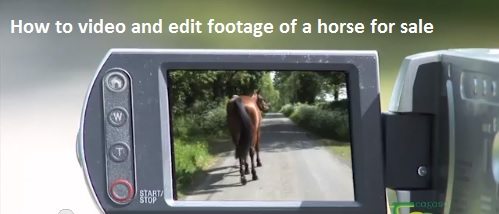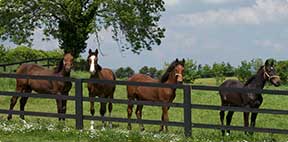Selling Advice

Good photos
When uploading photos of your horse or pony, be aware that this is your sales pitch and presentation to potential customers. No amount of words will make up for a bad photo/video.
Taking a suitable photograph in open stance
- Background – preferably a tidy, solid neutral background e.g. a wall or hedge.
- Horse should be turned out impeccably – clean, feet trimmed, mane and tail tidy, mane lying on off side (or plaited).
- Wearing a bridle if aged three and over; otherwise a head collar (preferably leather); all tack used should be clean and properly fitted.
- Preferably standing on a hard surface.
- Presented in open stance – near fore directly under the shoulder, near hind directly under the point of buttock, with the off fore slightly behind the near fore leg and off hind leg slightly in front of the near hind leg.
- Horse alert but relaxed, with ears pricked forward.
- Horse should be in the centre of the photograph.
Action Shots
- Take action shots – your horse or pony being ridden, lunging, jumping etc.
- If you decide to be in the photo, ensure your own appearance is smart.
Head Shot
Take a good head shot – horse alert with ears pricked forward.
Please note that it is recommended that three people are required to get a good photo.
- One to hold the horse.
- One to get the horse’s attention.
- One to take the photo.
Taking and producing a video clip
Teagasc Video Tutorials – How to Video and Edit Footage of a Horse for Sale.
Declan McArdle of Teagasc has produced an excellent video series to show sellers how to video and edit footage of horses for sale.

Click here to view the Teagasc video series »
General tips on producing videos of horses for sale
- A tripod is advantageous in keeping camera shots steady.
- Select an area which is clean and has no distractions (including loose dogs or other horses).
- If your own facilities are not suitable, hire a suitable venue instead.
- Avoid using the camera zoom (in and out) particularly in poorly lit areas. The camera will have difficulty re-adjusting focus and the image will become blurred and unusable.
Video to include
- Open stance – same recommendations apply as for photograph.
- Hard surface for movement – show walking/trotting away and towards the camera.
- Young horses – show loose movement, preferably in an arena – trot and canter on both reins.
- Three year olds – show loose movement and jumping or lunging over a fence.
- Ridden under saddle – show all three paces on both reins; rider must wear a hard hat and be tidily clad.
- Show clip of jumping a course of fences; if footage is available from a show, incorporate it into the final edit.
- For Eventers – show on the flat, over show jumps and cross country fences.
Other possible shots to include, particularly if aiming at the amateur market –
- Loading.
- Clipping.
- Being shod/ feet picked out.
- Standing for mounting.
- Hacking on the roads with traffic.
- Footage/ photos out hunting etc.
Options when editing video footage:
- Include text – Horse’s name, age, height, pedigree.
- Additional information – performance achievements of dam line/siblings and horse itself.
- Remove recorded audio from video, unless a commentary adds to marketing (for example audio at a show).
- Add music – pick music which ‘carries’ the pace of the clip but is not a distraction – be conscious of copyright on commercial music tracks.
- Clips should be ideally be in the region of 2.5 to 4.5 minutes.
- Discrete ‘effects and transitions’ will add to the quality of the presentation, however, if overdone they act as a distraction.
- Remember, the idea of the video clip is to gain and hold a customer’s attention regarding your horse. How the video is edited can play a significant role in helping to sell your horse.
Thanks to Declan McCardle of Teagasc for proving this information.
Your Ad
- When writing your advertorial for your horse or pony, make sure you include its merits and qualities and his personality.
- Ask yourself who would this horse be ideal for – is it a riding club, leisure, amateur or professional sports horse or pony?
- List your horses or pony’s level – novice, intermediate or advanced.
- Don’t oversell your horse or pony thinking it is worth more than the market will bear – be realistic.
Pricing
Potential buyers of horses often have a budget to spend, and like to know the price categories of horse.
- “POA” can often put people off contacting a seller unless the horse is very exceptional.
- Be aware that you want to engage buyers and sell horses, and not put obstacles in their way.
- Pricing your horse within a price band allows room for negotiation on both sides and your horse will feature more predominantly on the site through the search engine.









